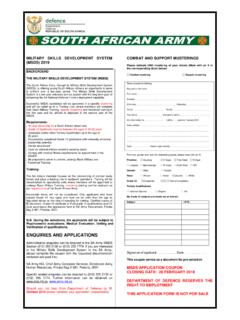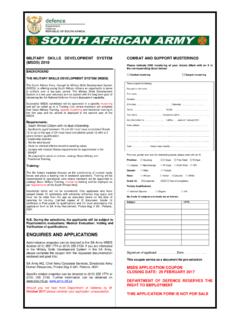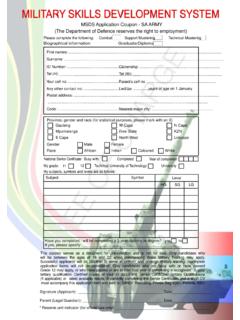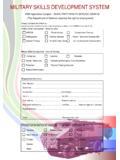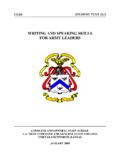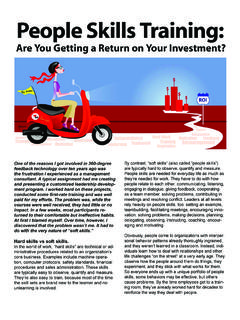Transcription of ENGAGEMENT SKILLS TRAINER: THE COMMANDER’S …
1 ENGAGEMENT SKILLS TRAINER: THE COMMANDER S PERSPECTIVE A thesis presented to the Faculty of the Army Command and General Staff College in partial fulfillment of the requirements for the degree MASTER OF MILITARY ART AND SCIENCE General Studies by RYAN DEBELTZ, MAJOR, ARMY , University of Wisconsin-Eau Claire, Wisconsin, 1997 Fort Leavenworth, Kansas 2017 Approved for public release; distribution is unlimited. Fair use determination or copyright permission has been obtained for the inclusion of pictures, maps, graphics, and any other works incorporated into this manuscript. A work of the United States Government is not subject to copyright, however further publication or sale of copyrighted images is not permissible. ii REPORT DOCUMENTATION PAGE Form Approved OMB No. 0704-0188 Public reporting burden for this collection of information is estimated to average 1 hour per response, including the time for reviewing instructions, searching existing data sources, gathering and maintaining the data needed, and completing and reviewing this collection of information.
2 Send comments regarding this burden estimate or any other aspect of this collection of information, including suggestions for reducing this burden to Department of Defense, Washington Headquarters Services, Directorate for Information Operations and Reports (0704-0188), 1215 Jefferson Davis Highway, Suite 1204, Arlington, VA 22202-4302. Respondents should be aware that notwithstanding any other provision of law, no person shall be subject to any penalty for failing to comply with a collection of information if it does not display a currently valid OMB control number. PLEASE DO NOT RETURN YOUR FORM TO THE ABOVE ADDRESS. 1. REPORT DATE (DD-MM-YYYY) 9-06-2017 2. REPORT TYPE Master s Thesis 3. DATES COVERED (From - To) AUG 2016 JUN 2017 4. TITLE AND SUBTITLE ENGAGEMENT SKILLS Trainer: The Commander s Perspective 5a. CONTRACT NUMBER 5b. GRANT NUMBER 5c. PROGRAM ELEMENT NUMBER 6.
3 AUTHOR(S) Ryan Debeltz, Major, Army 5d. PROJECT NUMBER 5e. TASK NUMBER 5f. WORK UNIT NUMBER 7. PERFORMING ORGANIZATION NAME(S) AND ADDRESS(ES) Army Command and General Staff College ATTN: ATZL-SWD-GD Fort Leavenworth, KS 66027-2301 8. PERFORMING ORG REPORT NUMBER 9. SPONSORING / MONITORING AGENCY NAME(S) AND ADDRESS(ES) 10. SPONSOR/MONITOR S ACRONYM(S) 11. SPONSOR/MONITOR S REPORT NUMBER(S) 12. DISTRIBUTION / AVAILABILITY STATEMENT Approved for Public Release; Distribution is Unlimited 13. SUPPLEMENTARY NOTES 14. ABSTRACT The use of simulations is in an evolving capability in the Army. The ENGAGEMENT SKILLS Trainer (EST) is a simulated rifle marksmanship trainer. Past research shows the EST is a cost-effective trainer. Research does not show how commanders use the EST in their training program. The study interviewed twenty previous company commanders. The study determined that commanders moderately used the EST in their unit training plans.
4 Moderate is defined as greater than 50 percent used two or more of the EST training capabilities: individual, crew, and judgment training. In this study, commanders only scheduled the EST as part of primary marksmanship instruction. However, ten of the nineteen commanders used an additional training capability of the EST. The study concluded with recommendations to improve EST use. The author recommends making EST a mandatory part of marksmanship training. The author also recommends using EST as a record of fire for a sustainment training event. This record of fire event can only occur once per year and after a live fire qualification. 15. SUBJECT TERMS ENGAGEMENT SKILLS Trainer, rifle marksmanship training 16. SECURITY CLASSIFICATION OF: 17. LIMITATION OF ABSTRACT 18. NUMBER OF PAGES 19a. NAME OF RESPONSIBLE PERSON a. REPORT b. ABSTRACT c. THIS PAGE 19b. PHONE NUMBER (include area code) (U) (U) (U) (U) 91 Standard Form 298 (Rev.)
5 8-98) Prescribed by ANSI Std. iii MASTER OF MILITARY ART AND SCIENCE THESIS APPROVAL PAGE Name of Candidate: Major Ryan Debeltz Thesis Title: ENGAGEMENT SKILLS Trainer: The Commander s Perspective Approved by: , Thesis Committee Chair James J. Sterrett, , Member Michael T. Chychota, , Member LTC Peter C. Boyer, Accepted this 9th day of June 2017 by: , Director, Graduate Degree Programs Prisco R. Hernandez, The opinions and conclusions expressed herein are those of the student author and do not necessarily represent the views of the Army Command and General Staff College or any other governmental agency. (References to this study should include the foregoing statement.) iv ABSTRACT ENGAGEMENT SKILLS TRAINER: THE COMMANDER S PERSPECTIVE, by Major Ryan Debeltz, 91 pages. The use of simulations is in an evolving capability in the Army. The ENGAGEMENT SKILLS Trainer (EST) is a simulated rifle marksmanship trainer.
6 Past research shows the EST is a cost-effective trainer. Research does not show how commanders use the EST in their training program. The study interviewed twenty previous company commanders. The study determined that commanders moderately used the EST in their unit training plans. Moderate is defined as greater than 50 percent used two or more of the EST training capabilities: individual, crew, and judgment training. In this study, commanders only scheduled the EST as part of primary marksmanship instruction. However, ten of the nineteen commanders used an additional training capability of the EST. The study concluded with recommendations to improve EST use. The author recommends making EST a mandatory part of marksmanship training. The author also recommends using EST as a record of fire for a sustainment training event. This record of fire event can only occur once per year and after a live fire qualification.
7 V ACKNOWLEDGMENTS The author would like to thank the following persons for their contribution to the research. To the thesis committee, Dr. Sterrett, Mr. Chychota, and LTC Boyer, for their research education, development, and patience. To my wife for unwavering support, understanding, and encouragement. To the commanders for their participation in the study To Mr. Robert Munsey, MAJ Chris Finnigan, and Mr. John Bess for sharing their knowledge. To Programs and Resources Directorate TRADOC Analysis Center (TRAC) for authorization to used previous research marked FOUO. To CAC-T Mr. Mark Mueller for authorization to used previous research marked FOUO. To Ms. Bonnie Joranko, my editor, for development and guidance. vi TABLE OF CONTENTS Page MASTER OF MILITARY ART AND SCIENCE THESIS APPROVAL PAGE .. iii ABSTRACT .. iv ACKNOWLEDGMENTS ..v TABLE OF CONTENTS .. vi ACRONYMS .. viii ILLUSTRATIONS.
8 Ix CHAPTER 1 INTRODUCTION ..1 Overview .. 1 Purpose .. 5 Research Question .. 5 Data Collection Plan .. 7 Assumptions .. 7 Limitations and Delimitations .. 8 Significance of Research .. 10 CHAPTER 2 LITERATURE REVIEW ..12 Overview .. 12 Doctrine .. 12 Development and Procurement .. 15 Training .. 16 Performance .. 19 Cost Benefit .. 22 Summary .. 23 CHAPTER 3 RESEARCH METHODOLOGY ..25 Purpose .. 25 Setting and Participants .. 26 Research Approval .. 27 Research Question .. 27 Administrative Information .. 28 Subsequent Research Questions .. 28 Data Collection .. 31 Summary .. 31 vii CHAPTER 4 ANALYSIS ..32 Introduction .. 32 Population Data .. 34 Secondary Question #1 How Often Was the EST Used? .. 38 Secondary Question #2 Why Did Commanders Use the EST? .. 42 Secondary Question #3 Will EST Use Improve Unit Capabilities? .. 46 Secondary Question #4 Why is the EST Not Used More? .. 48 Primary Research Question Can EST Use Be Improved?
9 50 Conclusion .. 51 CHAPTER 5 CONCLUSIONS AND RECOMMENDATIONS ..53 Introduction .. 53 Summary of Study .. 53 Recommendations .. 55 Conclusion .. 59 APPENDIX A INFORMED CONSENT FORM FOR QUALITATIVE STUDY ..61 Qualitative Study Related to EST and Commander s Training Program .. 61 Purpose .. 61 Participation Requirements .. 61 Potential Risks/Discomfort .. 62 Potential Benefit .. 62 Anonymity/Confidentiality .. 62 Right to Withdraw .. 63 Contacts for Additional Assistance .. 63 APPENDIX B COMPOSITE INTERVIEW RESPONSES ..64 Administrative Questions .. 64 Interview Questions .. 68 BIBLIOGRAPHY ..80 viii ACRONYMS ARNG Army National Guard AS3 Assistant Staff Officer to the S3 ATP Army Technical Publications BRM Basic Riffle Marksmanship CBRN Chemical Biological Radiological and Nuclear CGSOC Command and General Staff Officers Course DMG Digital Master Gunner EST ENGAGEMENT SKILLS Trainer FORSCOM.
10 Army Forces Command FOUO For Official Use Only HPA Human Protections Administration NCO Non-Commissioned Officer PMI Preliminary Marksmanship Instruction TRADOC . Army Training and Doctrine Command TSAID Training Support Analysis Integration Directorate WTU Warrior Transition Unit ix ILLUSTRATIONS Page Figure 1. EST Overview..3 Figure 2. Marksmanship Training Progression..14 Figure 3. Length of Command ..36 Figure 4. EST Use ..40 Figure 5. Number of EST Training Capabilities Used ..43 Figure 6. Individual Familiarization Fires ..45 1 CHAPTER 1 INTRODUCTION The potential for simulations in training cannot be overemphasized. Moreover, the use of simulations is grounded in our General Robert Cone, Military Review Overview You just lost ten million dollars, one-fifth of your annual budget. How will you prepare for war or complete your mission? What organizational changes have to be made, or what resources will be reduced?










